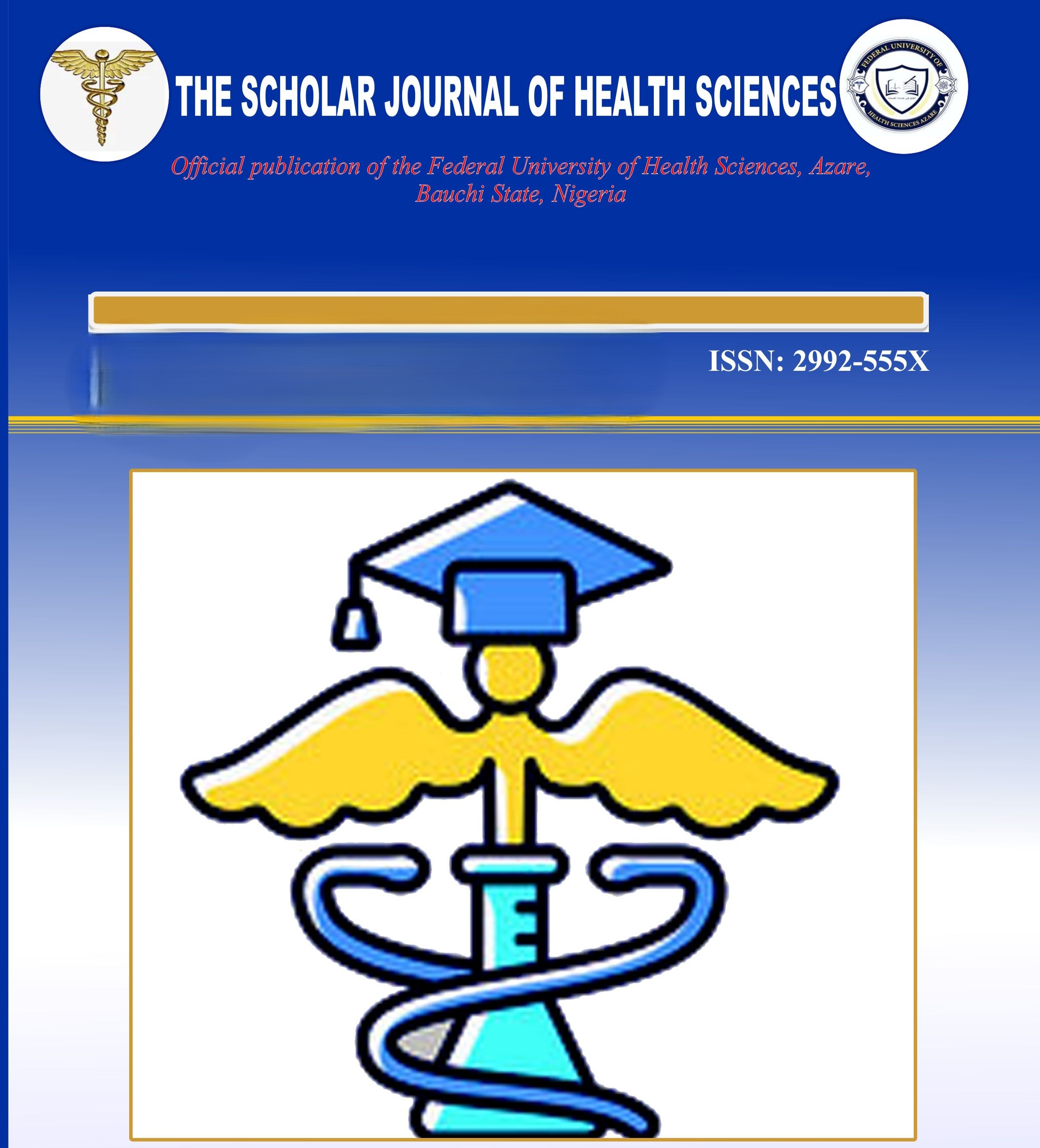Gastrointestinal cancers in Northeastern Nigeria: A review of demographic and histopathological characteristics
Keywords:
Gastrointestinal cancers, Histopathology, Demography, Cancer epidemiology, Northeastern NigeriaAbstract
Background: Gastrointestinal tract (GI) cancers are among the most common cancers affecting humans globally. The global incidence and mortality of the disease have demonstrated a significant temporal and geographic variation although the epidemiology and histopathologic characteristics have not been adequately reported among black Africans.
In Nigeria, there is poor characterization of the disease due to lack of studies that reflect the epidemiology of the disease. This study aimed to examine the demographic and histopathological characteristics of gastrointestinal cancers in Northeastern Nigeria.
Methods: This was a quantitative retrospective analysis of patients diagnosed with gastrointestinal cancers at six tertiary institutions in Northeastern Nigeria from January 2019 to December 2022. We selected six major tertiary referral centers in order to get diverse and representative data. Patient’s information retrieved included age, gender, organ(s) affected, tumor sub-sites, histological diagnosis, and histological sub-type of the tumor. The data collected was analyzed using SPSS version 26 (IBM SPSS Inc., Chicago, Illinois, USA).
Results: A total of 579 patients were reviewed, within the age range 2 - 92 years, and a median age of 52 years. The incidence of GI cancers in this study was 16.1% (579/3596). There were 348 (60.1%) males and 231 (39.9%) females, with male-female ratio of 1.5:1. The majority of the patients 390 (74.4%) were 40 years or older. The common sites affected were the colorectal 279 (48.2%), liver 124 (21.4%), stomach 109 (18.8%), small intestine 32 (5.5%), esophagus 26 (4.5%), and pancreas 9 (1.6%). Overall, epithelial cancers (predominantly adenocarcinoma) were the commonest representing about 88.4% of the cases (512/579). All the pancreatic cancers were derived from the pancreatic ducts with 4 of them located at the head of the pancreas, while majority of the esophageal cancers were squamous cell carcinoma 15/26 (57.7%).
Conclusion: The incidence of GI cancers in Northeastern Nigeria was 16.1%. The incidence is increasing with age, with a male preponderance. The most common site affected was the colorectal region, followed by the liver and stomach. The colorectal adenocarcinoma, gastric adenocarcinoma, and hepatocellular carcinoma are the most common histological subtypes.
References
. Fitzmaurice C, Dicker D, Pain A, Hamavid H, Moradi-Lakeh M, MacIntyre MF, Allen C, Hansen G, Woodbrook R, Wolfe C, Hamadeh RR. The global burden of cancer 2013. JAMA oncology. 2015 Jul 1;1(4):505-27.
Xia C, Dong X, Li H, Cao M, Sun D, He S, Yang F, Yan X, Zhang S, Li N, Chen W. Cancer statistics in China and United States, 2022: profiles, trends, and determinants. Chinese medical journal. 2022 Mar 5;135(05):584-90.
Siegel RL, Miller KD, Fuchs HE, Jemal A. Cancer statistics, 2022. CA Cancer J Clin 2022;72:7–33.
Kanavos P. The rising burden of cancer in the developing world. Annals of oncology. 2006 Jul 1;17:viii15-23.
Abbas Z, Rehman S. An overview of cancer treatment modalities. Neoplasm. 2018 Sep 19;1:139-57.
Xie Y, Shi L, He X, Luo Y. Gastrointestinal cancers in China, the USA, and Europe. Gastroenterology report. 2021 Apr 1;9(2):91-104.
Lu L, Mullins CS, Schafmayer C, Zeißig S, Linnebacher M. A global assessment of recent trends in gastrointestinal cancer and lifestyle-associated risk factors. Cancer Commun. 2021;41(11):1137–51.
Ferlay J, Ervik M, Lam F et al. Global Cancer Observatory: Cancer Today. Lyon: International Agency for Research on Cancer.https://gco.iarc.fr/today (26 October 2023, date accessed).
Pourhoseingholi MA, Vahedi M, Baghestani AR. Burden of gastrointestinal cancer in Asia; an overview. Gastroenterology and hepatology from bed to bench. 2015;8(1):19.
Arnold M, Abnet CC, Neale RE, Vignat J, Giovannucci EL, McGlynn KA, Bray F. Global burden of 5 major types of gastrointestinal cancer. Gastroenterology. 2020 Jul 1;159(1):335-49.
Makmun D, Simadibrata M, Abdullah M, Syam AF, Fauzi A, Renaldi K, Rani A, Krisnuhoni E. Changing trends in gastrointestinal malignancy in Indonesia: The Jakarta experience. J Cancer Res Ther. 2014;2(9):160-8.
Obiorah C, Ray-Offor E. Epidemiology of Gastrointestinal Malignancies in Nigeria: Port Harcourt Cancer Registry Study. Oncology Journal of India. 2020 Jan 1;4(1):1-4.
Abudu EK, Akinbami OS. Histopathologic Prolife of Primary Gastrointestinal Malignancies in Uyo City (Niger-Delta Region of Nigeria). Rare Tumors. 2016 03 31;8(1):27-29.
Uchendu OJ, Akpo EE. Primary Gastrointestinal Tract Cancers in Nigeria, Epidemiological and Histopathological Study. Asian Pacific Journal of Cancer Care. 2021 Mar 26;6(1):3-7.
Bray F, Ferlay J, Soerjomataram I, Siegel RL, Torre LA, Jemal A. Global cancer statistics 2018: GLOBOCAN estimates of incidence and mortality worldwide for 36 cancers in 185 countries. CA: A Cancer Journal for Clinicians. 2018, 09 12;68(6):394-424.
Olusegun O. Spatial and socio-demographic disparities of cancer morbidity in Nigeria: Patterns and factors. Geografia. 2014;10(1); 25-35.
Attar A, Malka D, Sabaté JM, Bonnetain F, Lecomte T, Aparicio T, Locher C, Laharie D, Ezenfis J, Taieb J. Malnutrition is high and underestimated during chemotherapy in gastrointestinal cancer: an AGEO prospective cross-sectional multicenter study. Nutrition and cancer. 2012 May 1;64(4):535-42.
Irabor DO. Diet, environmental factors and increasing incidence of colorectal cancer in Nigeria. Ann Nigerian Med. 2014 Jul 1;8(2):58-64.
Pratt MM, John K, MacLean AB, Afework S, Phillips DH, Poirier MC. Polycyclic aromatic hydrocarbon (PAH) exposure and DNA adduct semi-quantitation in archived human tissues. Int J Environ Res Public Health 2011;8:2675-91.
Silva BO, Adetunde TO, Oluseyi TO, Olayinka KO, Alo BI. Effects of the methods of smoking on the levels of polycyclic aromatic hydrocarbons (PAHs) in some locally consumed fishes in Nigeria. Afr J Food Sci 2011;5:384-91.
Brawley OW. Avoidable cancer deaths globally. CA Cancer J Clin. 2011;61:67-8.
Salawu FK, Danburam A, Desalu OO, Olokoba AB, Agbo J, Midala JK, et al. Cigarette smoking habits among adolescents in northeast Nigeria. Mera Afr J Respir Med 2009;1:9-11.
Krivoshto IN, Richards JR, Albertson TE, Derlet RW. The toxicity of diesel exhaust: Implications for primary care. J Am Board Fam Med 2008;21:55-62.
Shehu M, Abba A. Humanitarian crisis and sustainable development: perspectives and preferences of internally displaced persons in the northeastern Nigeria. Journal of International Humanitarian Action. 2020 Dec;5(1):17; 2-10.
Abubakar MS, Musa AM, Ahmed A, Hussaini IM. The perception and practice of traditional medicine in the treatment of cancers and inflammations by the Hausa and Fulani tribes of Northern Nigeria. Journal of Ethnopharmacology. 2007 May 22;111(3):625-9.
Valarini SB, Bortoli VT, Wassano NS, Pukanski MF, Maggi DC, Bertollo LA. Correlation between location, size and histologic type of colorectal polyps at the presence of dysplasia and adenocarcinoma. Journal of Coloproctology (Rio de Janeiro). 2011;31:241-7.
Almasi Z, Rafiemanesh H, Salehiniya H. Epidemiology characteristics and trends of incidence and morphology of stomach cancer in Iran. Asian Pacific journal of cancer prevention. 2015;16(7):2757-61.
Săftoiu A, Hassan C, Areia M, Bhutani MS, Bisschops R, Bories E, Cazacu IM, Dekker E, Deprez PH, Pereira SP, Senore C. Role of gastrointestinal endoscopy in the screening of digestive tract cancers in Europe: European Society of Gastrointestinal Endoscopy (ESGE) Position Statement. Endoscopy. 2020 Apr;52(04):293-304.
Okwonkwo UC, Nwosu MN, Ukah C, Okpala OC, Ahaneku JI. The Clinical and Pathological Features of Hepatocellular Carcinoma in Nnewi, Nigeria. Nigerian Journal of Medicine. 2011;20(3): 366 - 371.
Ifeanyi OE. A Review on Hepatitis B Virus and Hepatocellular Carcinoma. Cancer Therapy & Oncology International Journal. 2018;10(2):26-31.
Downloads
Published
Data Availability Statement
Acknowledgements: The authors wish to acknowledge the support of the following Histopathologists at the various Hospitals who provided the primary data for the study namely Uchenna S. E, Dauda E. S, Lawan I. A, Abba K, Adamu I A and Modu A. K.
Availability of data and materials: The data used during this study are available from the corresponding author on request.
Ethics approval
Ethical approval was not required because it was a retrospective study, no human participants or human specimen was used. The waiver for this research was granted by the Research and ethic committee of Federal Medical Center, Azare, Nigeria.
Conflict of interest: The authors declare that the research was conducted in the absence of any commercial or financial relationships that could be construed as a potential conflict of interest.
Funding: No funding was received for this work.





